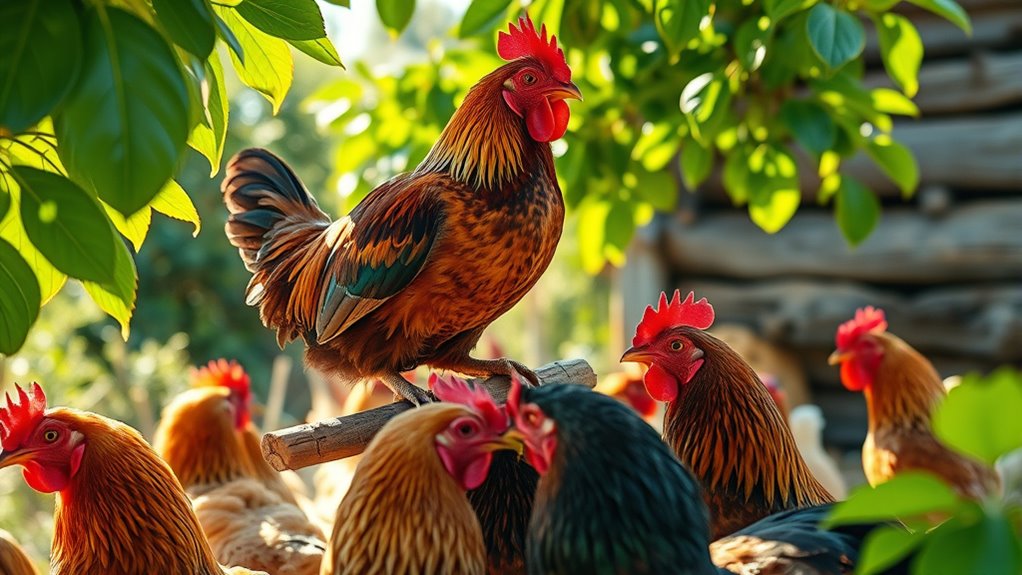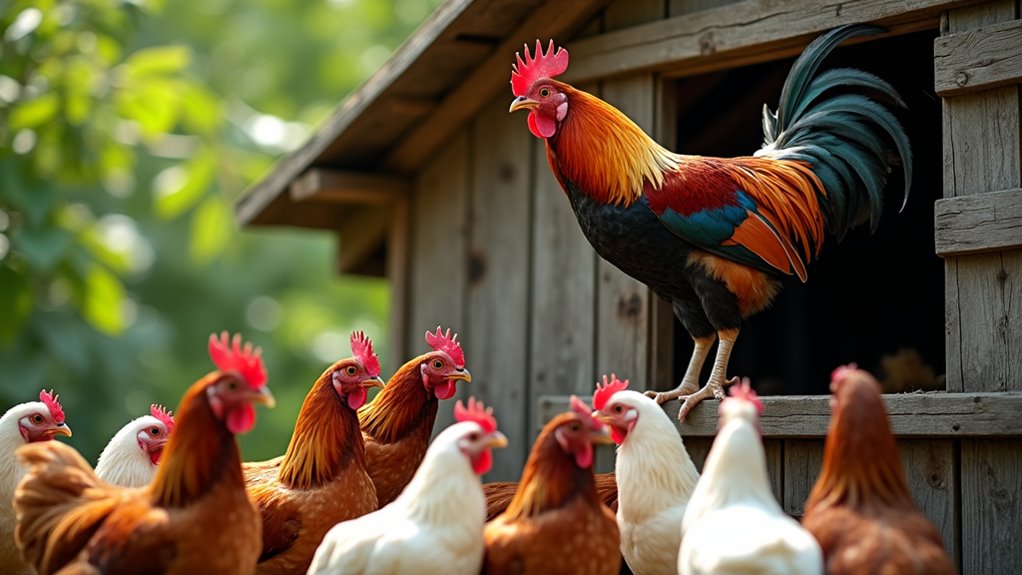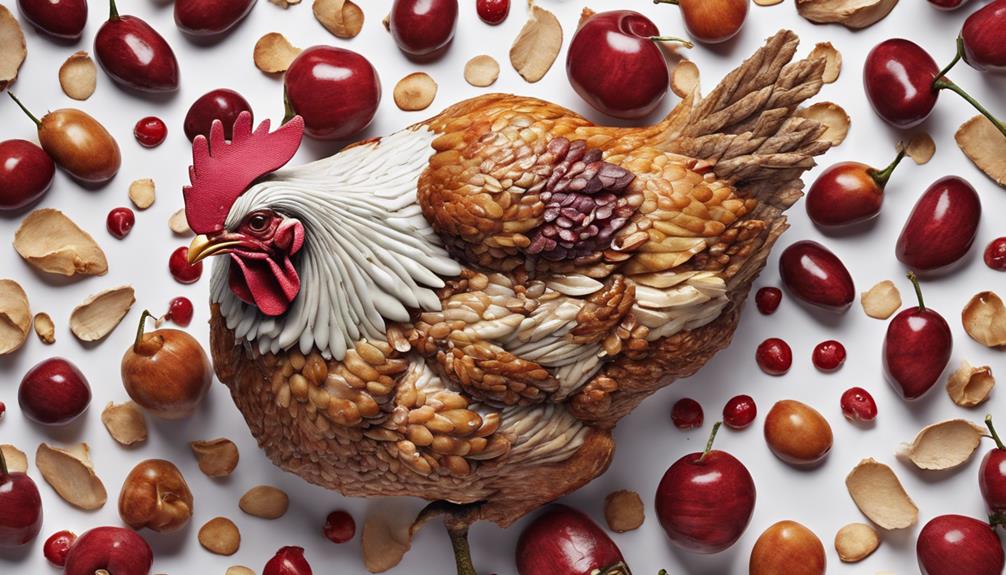Understanding the pecking order helps you see how chickens establish social rankings within their flock. Chickens use behaviors like pecking, chasing, and posturing to assert dominance, while subordinates often show retreat or submission. Providing ample space, resources, and hiding spots keeps conflicts manageable, reducing stress and injuries. Observing these interactions allows you to support a stable hierarchy. If you want to learn how to maintain a peaceful flock and promote natural social behaviors, keep exploring these key dynamics.
Key Takeaways
- The pecking order establishes social hierarchy, determining access to food, roosts, and attention within the flock.
- Dominant chickens assert rank through pecking, chasing, and confident behaviors like puffing up.
- Subordinate chickens show submissive signals and tend to avoid confrontation to maintain safety.
- Environmental factors like adequate space and multiple resource stations help reduce conflicts and stabilize hierarchy.
- Regular observation and understanding of social dynamics support a peaceful, healthy flock environment.

Chickens are highly social animals, and understanding their behavior can help you create a healthier, more harmonious flock. One of the most important aspects of their social structure is the pecking order, which is fundamentally a ranking system that establishes social dominance within the flock. This hierarchy determines who eats first, who gets the best roosting spots, and even who receives attention from the flock’s leaders. Recognizing and respecting this pecking hierarchy is crucial for maintaining flock stability. When chickens establish social dominance, they assert their position through a series of behaviors, including pecking, chasing, and posturing. These actions aren’t random; they serve as communication tools to establish rank without unnecessary violence. As a chicken owner, you’ll notice that dominant birds often display more confident behaviors, such as puffing up their chests or standing tall, signaling their status to others. Subordinate chickens, on the other hand, tend to keep a lower profile, avoiding direct confrontation with their more assertive flock mates.
Understanding these social signals helps you manage your flock better. If you see a chicken consistently harassing others or pecking aggressively, it might be trying to assert dominance or could be experiencing stress. Sometimes, dominance disputes are resolved quickly, with one bird clearly establishing itself as the leader, while other times, you might witness ongoing pecking conflicts that can cause injuries or stress. To promote a balanced pecking hierarchy, it’s necessary to ensure your chickens have enough space, resources, and hideouts to retreat when needed. Overcrowding can intensify pecking and fighting, disrupting the social order and leading to injuries or pecking injuries. Providing multiple feeders and water stations helps reduce competition and prevents dominant chickens from monopolizing resources, which can upset the social balance. Additionally, resource distribution plays a vital role in keeping the social structure stable and reducing conflicts among flock members. Ensuring proper environmental enrichment can also help reduce boredom and aggressive behaviors. Incorporating space management strategies can further support a peaceful hierarchy by minimizing stress and territorial disputes.
You should also observe the flock’s dynamic regularly. When you notice the dominant chicken asserting itself or subordinates retreating, you’re witnessing the natural process of social dominance at work. It’s important to let this process unfold naturally, as interference can sometimes cause more conflict or stress. Additionally, social behavior monitoring is a valuable tool to detect early signs of imbalance or stress, helping you intervene proactively. Understanding the hierarchical structure of your flock enables you to create an environment that supports natural social interactions and reduces unnecessary conflicts. Remember, a well-structured hierarchy keeps your chickens happier, healthier, and more productive, making your job as a caretaker much easier and more enjoyable.
Frequently Asked Questions
How Does the Pecking Order Develop in New Chicken Flocks?
When new chicken flocks form, you’ll notice the chicken hierarchy developing quickly. The dominant hens establish their place through pecking and social bonding, which helps reduce conflicts. You might see minor squabbles as they figure out roles, but once the hierarchy is set, social bonding becomes stronger, and the flock runs smoothly. Understanding this process helps you manage your chickens better and promote a peaceful, well-organized flock.
Can a Chicken Change Its Social Rank Over Time?
Your curiosity is as sharp as a hawk’s eye! Yes, a chicken can change its social rank over time, especially if circumstances shift. Hierarchy stability isn’t set in stone; chickens experience social mobility based on health, behavior, and environment. Sometimes a lower-ranking hen can rise if a dominant one is removed or weakens. So, in chicken society, ranks are more fluid than you might think!
What Behaviors Indicate a Chicken Is Asserting Dominance?
When observing a chicken asserting dominance, look for specific behaviors. Dominance displays include standing tall, puffing up feathers, and making direct eye contact. You’ll notice aggressive pecking aimed at other chickens, often accompanied by chasing or blocking their movement. These actions help establish social rank, showing the chicken is trying to assert control. Recognizing these signals helps you understand how chickens communicate their position within the flock.
How Does the Pecking Order Affect Egg Production?
You might think the pecking order doesn’t impact egg production, but it does, especially in cage confinement. When chickens establish dominance, they experience less stress and better social harmony, boosting their egg-laying. Conversely, aggressive pecking can cause stress, lowering productivity. A proper diet also plays a role, ensuring chickens have the nutrients needed for consistent egg production. So, understanding social behavior helps optimize their environment and dietary impact for healthier, more productive hens.
Are There Differences in Social Hierarchy Among Breeds?
You’ll find that social hierarchy varies among breeds due to breed-specific hierarchy and temperament differences. Some breeds have a more defined pecking order, making their social interactions more structured, while others are more relaxed. Your choice of breed influences how chickens establish dominance and interact, so understanding these differences helps you manage your flock better. Recognizing breed-specific hierarchy and temperament differences guarantees a healthier, more harmonious environment for your chickens.
Conclusion
Now, you understand how chickens establish their pecking order, with the top bird asserting dominance through subtle cues. Did you know that in a flock of 30, the highest-ranking hen can influence over 80% of the group’s social interactions? By recognizing these behaviors, you can better care for your chickens and promote a harmonious environment. Remember, observing their social dynamics helps you guarantee they stay healthy and stress-free.










